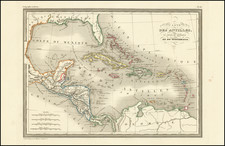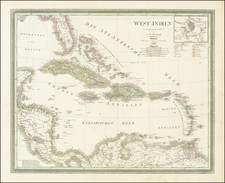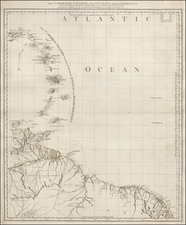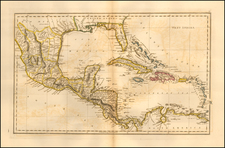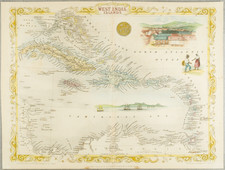Rare separately issued chart of the bay of Jagua (now Bahia de Cienfuegos) on the southern coast of Cuba, published in Paris by Lemercier.
The present chart would seen to be the first printed appearance of Felix Bouyon's original survey of Jagua, undertaken in connection with the first modern attempt to colonize the region with a European populace.
The modern history of Cienfuegos begins on January 1, 1819 when Lieutenant Colonel Don Luis Juan Lorenzo De Clouet de Piette proposed to Captain General Don Jose Cienfuegos and to Intendente Don Alejandro Ramirez to colonize the bay of Jagua. This proposal was accepted and formalized on March 9, 1819, in accordance with the Royal Cedula of October 21, 1817 intended to increase the European population of the Island.
Clouet arrived on April 8, 1819, by way of Batabanó, accompanied by 46 colonists from Burdeos (Bordeaux), France who arrived in three ships, the Juan Bart, the Joven Emanuel and the Activo. They were also accompanied by a doctor, don Domingo Monjenie and a public surveyor, Don Miguel Dubroet, appointed by the government to distribute the lands. These colonists lived in tents, at the location where the Plaza de Armas is now, until some houses could be built.
At the same time Felix Bouyon of the Spanish Royal Navy perfomed a survey of the bay, measured the land and created a map of the peninsula of Majagua. The formal founding of the colony took place on April 22,1819 when De Clouet took possession of the peninsula in the name of the King of Spain and in the presence of the Captain Commander of the Castle of Jagua, Don Joaquin Horruytiner, Don Tomas de Calderon de la Barca, Don Antonio Casales, Don Gregorio Garrido, Don Miguel de la Torre and other colonists.
The Bay of Jagua (Cienfuegos) has a rich 500 year history, which includes a brief period as the main base of the Spanish Military Command in 1762, during the period when the English occupied the island. The Bay was visited very early in the history of the island. For example, Pánfilo de Narváez and Alvar Nuñez Cabeza de Vaca wintered in the bay in 1527-1528. In the middle of the 16th Century, it was a haven for priates, including Jacques de Sores (1554), Francis Drake (1586), and other more frequent visitors, such as John Morgan, Jean Giron Fearless, and Guillermo Bruce.
The map key (lower left) provides details for a number of other places denoted only with letters.
Upon completion, Castillo del Jagua was the third most important fort on Cuba, after the El Morro Castle in Havana and the El Morro Castle in Santiago de Cuba. In 1762, it was the seat of the Spanish military command, during the brief English occupation of the Island. The first commander of the castle was Don José Castilla Cabeza de Vaca. The castle was equipped with 10 large caliber cannons; four 18-pounders on the uppermost level and four 24-pounders and two 8 pounds on the lower level. The castle still has a functioning wooden drawbridge over a dry moat.
The map is very rare. We note an example listed in Mapoteca Columbiana, but no recorded surviving examples.









![[Hand Drawn Map] Le Golfe de Mexique avec les Pays Circonvoisins](https://storage.googleapis.com/raremaps/img/small/91580.jpg)
